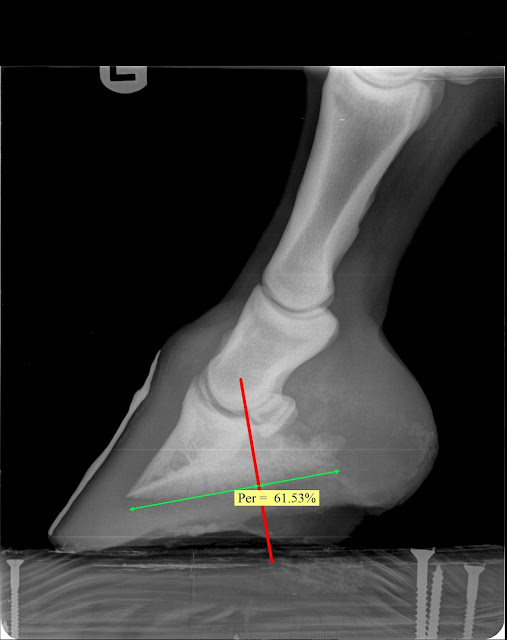Change a few of these parameters and you start to identify mechanical handicaps that increase forces on growth centers and reduce blood flow hence reducing horn/sole growth. The most relevant difference I see is the bone angle, the toe lever and relative deep digital flexor tension/length. These are characteristics that a horse is born with. A lower bone angle and longer coffin bone (toe lever) often go hand in hand. This creates a longer lever arm acting against the flexor tendon and the bone to hoof attachment at the toe. On the other hand take a club foot with shortened muscle/tendon unit that overloads the toe area and this excessive force is responsible for the lack proper circulation and growth even with a shorter toe lever. Depending on the severity of these genetic handicaps and the goal for the horse will determine whether or not your horse will do good as a barefoot candidate.
 |
| Note a short toe lever. When evaluated from COA to tip of coffin bone. This horse maintained good sole depth and hoof quality with minimal trimming. |
Yes, sometimes a shoe can be detrimental to the hoof if attention is not given to recognizing these handicaps and altering the mechanics with the shoe application. For example a long toe lever and long coffin bone would benefit from a shoe application that reduced the toe lever. Examples are a rolled toe, rocker toe, natural balance or rocker shoe. This allows a reduction in the moment arm and reduces the force transmitted against the deep flexor tendon. This reduces subsequent tension force on the horn-lamellar junction, compression force at the solar corium and navicular bone tendon interface.
I feel that earlier recognition and management of the these handicaps will reduce many problems that our horses experience later in life. Horses are such amazing beast and able to adapt and overcome problems for many years to only be painful in their later years. I feel a reduction in these forces, once recognized and shoeing plan altered, prior to training would reduce the accumulated trauma over the lifespan of the horse.
So my overall stance is: If your horse has good external and radiographic parameters and no genetic handicaps or disease processes that require unloading then by all means manage with a good barefoot trim. However if there is problem such as thin soles, navicular bone disease, laminitis, arthritis or white line disease, application of a shoe to place the forces in the horse's favor may be required. Many cases require our modification of the forces to keep the horse doing its job.
I think shoeing horses often gets a bad reputation because we fail to recognize that maybe a perimeter fit, flat shoe may not be the best for every horse. I see many that would be better off barefoot as the shoe is creating an ever lengthening toe lever that may have the chance to wear off, if the horse was barefoot.
So when and if I can manage horses barefoot I prefer the four point trim. It's ability to reduce digital breakover greatly enhances the quality of and quantity of growth. I think the secret is "less is more" This approach allows maintaining a short toe and toe lever with maximizing sole depth. This trim is typically a rasp only trim with minimal knifing of the frog and sole only to clean up any ragged frog or bars that may trap debri. Below is a short video demonstrating a four point trim and some images demonstrating some of the important aspects as well.
Points to remember:
1) Very good trimming approach to manage horse barefoot even with long toes and club as long as there is no other problems
2) Get paid for what you leave on the horse not what you are taking off.
3) When transitioning from shoes to barefoot, Take baby steps in applying any trim unless you have a ton of foot. Consider trimming every 2-3 weeks for 3 trims until you get the foot toughened.
4) I see great benefit from the use of Keratex hoof hardener and hot searing (Propane torch) my barefoot cases
5) Leave a nice round radius to the hoof wall and the hoof wall will be less likely to chip and more likely to self maintain.
 |
| Angle of Rasp for toe trim varies according to sole depth. |
 |
| Demonstration of the load zones with a four point trim |

